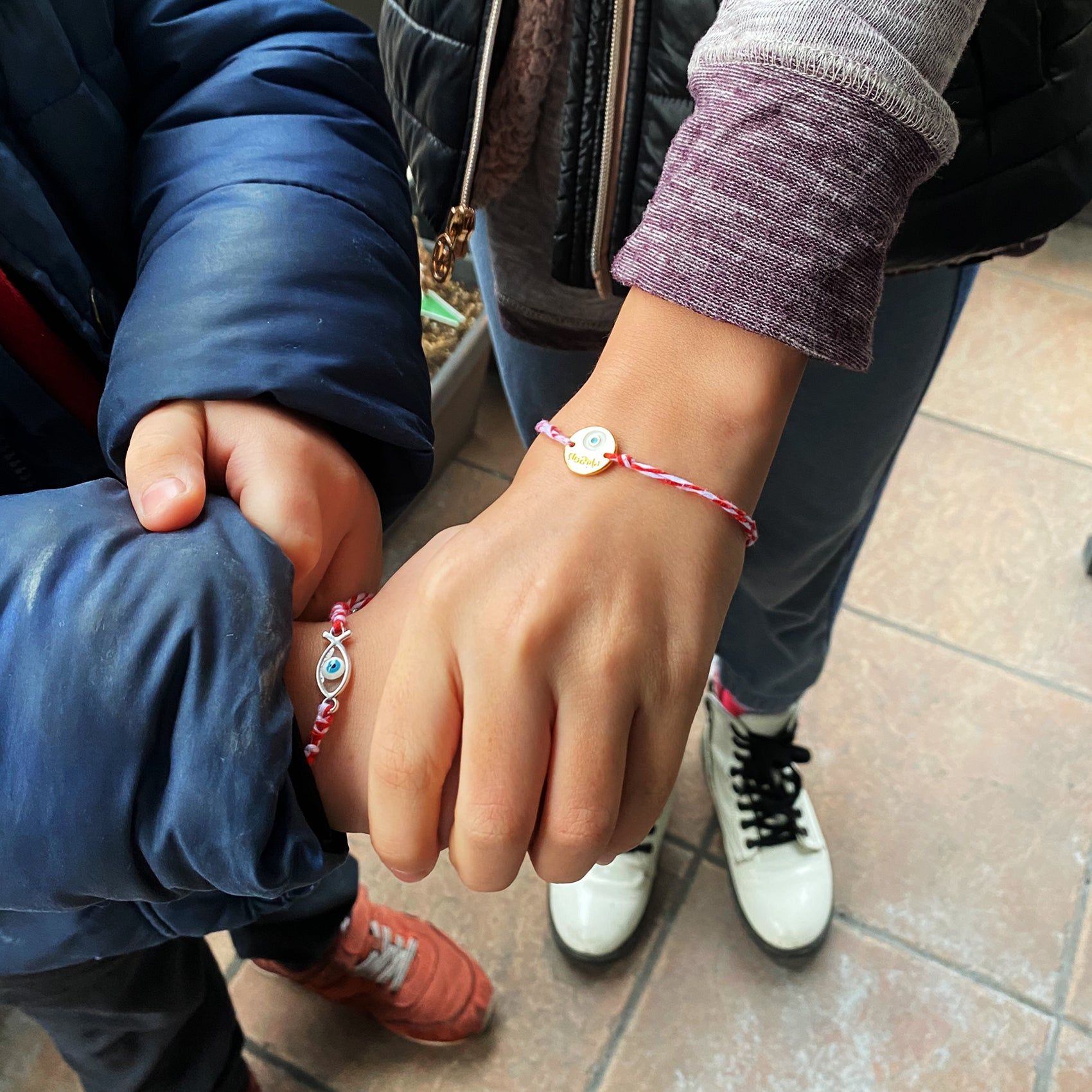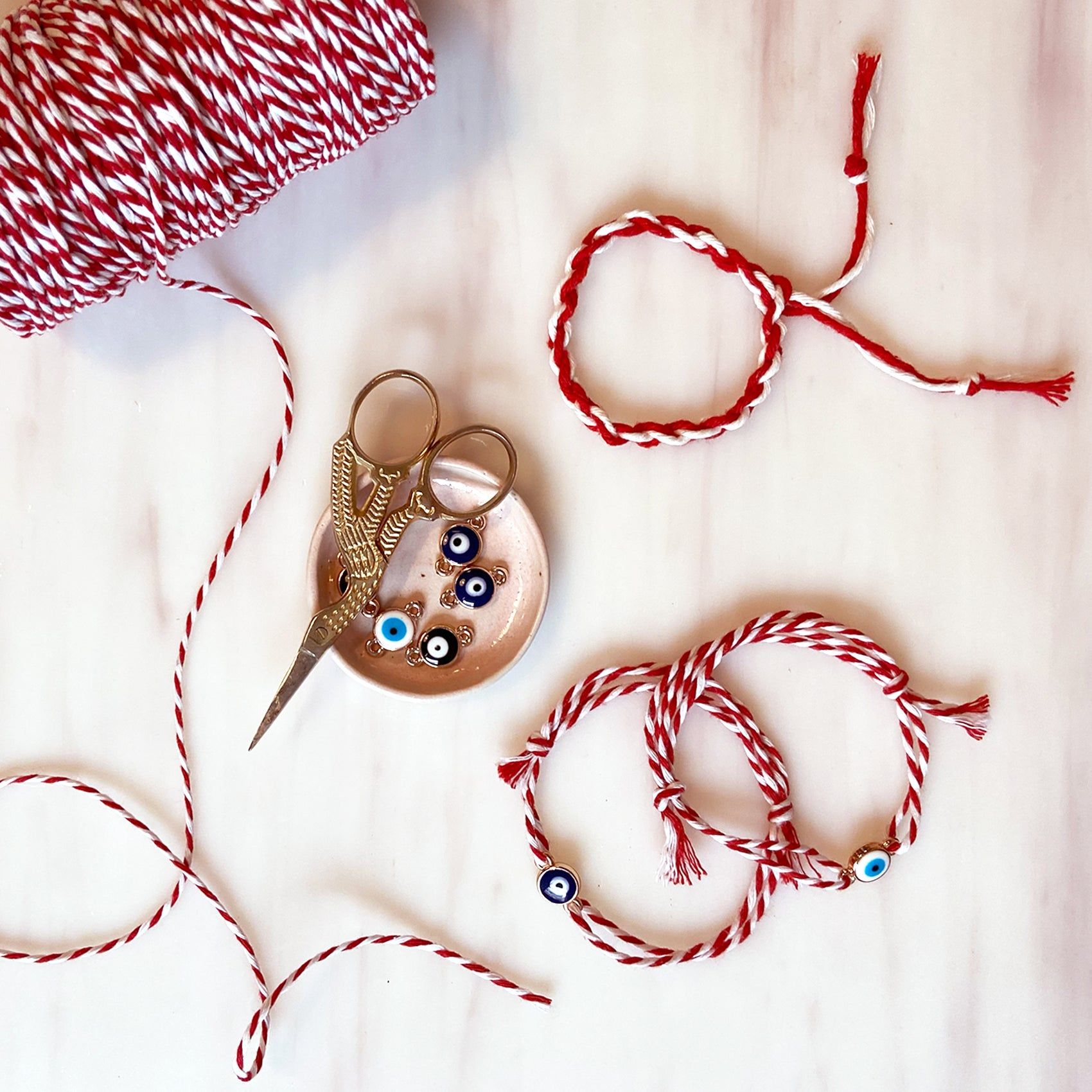
Everyday Magic
Marching On: Magic Bracelets and the Ties That Bind
She'll share a ritual steeped in tradition each month to give us a moment to slow down, observe the world around us and connect with who came before us. First up: martakia bracelets that announce the arrival of March (and sunny weather) across Greece.
- Written By
- Eleni N.Gage
Five minutes after we arrived in Miami and walked into my parents’ apartment, my daughter realized she’d left her tracker watch on the plane from New York. It’s not a fancy smartwatch—it came free when we added a $10 a month watch line to my cell phone plan. But it was a solution, a way I could communicate with my ten-year-old, and track her location, without getting her a smartphone to leave on a plane one day.
It was also a symbol—of her growing independence, and the fact that I’ll need to let her make her own way in the world. I had been using it as training wheels for next year’s middle school commute, which most 11-to-13-year olds in New York make on public transportation, riding the subways or buses alone or with fellow students. In preparation, I’ve let her walk three blocks to an after-school class, and send me a picture of herself with her teacher, snapped with her watch, to show that she got there. I even went to dinner with friends in the restaurant below our apartment, leaving her alone upstairs, checking in via watch text.
This is the rock and the hard place of parenting—you want your children to go out in the world, enjoy all its wonders, meet new people, and have adventures you never could have imagined. At the same time, you want to keep them as safe and close as the babies you once carried on your chest, tied to your body by a sling. We’d only had the watch for a couple of months. But wondering what we were going to do without it, even just for this vacation, had me anxious, even a little maudlin. Parents must have always felt this way, I mused, before smart watches, before mass transit, before zoom and facetime made it possible to communicate with children oceans, not blocks, away.
That’s when I remembered I had a low-tech solution in my own carry-on—something else my daughter can wear around her wrist, as a form of protection and symbol of connection. And—bonus!— it comes with centuries of focus group testing. Since we would still be in Miami on the last day of February, I packed a handful of martakia, red and white string bracelets that generations of Greek parents have wrapped around their children’s wrists come March, to offer them protection as the world opens up to spring again.
Depending on the part of Greece you’re in, this sign of the season may be called a martis, a martia, or a martaki—all variations on the word for March, the month when spring begins. The bicolored band can be worn on a child’s wrist as a bracelet or ring as a finger—and they’re not just for kids! Adults can sport them, too. I’d heard that villagers sometimes even tied larger versions to trees, to protect the people who walked under them, to rosebushes to help them grow strong, or, back in the day, around wells to keep the water cool come summer.
Versions of these bracelets are worn all over the Balkans, and some people theorize that they date back to ancient Greece, when participants in the Eleusinian mysteries, rites for Demeter and Persephone, wore strings around their wrists and ankles. More recently, a Greek news broadcast I watched explained that women would wrap these bracelets around their children’s wrists before letting them go outside to play in spring, on the theory that the martakia would protect them from getting burned by the March sun reappearing after a long winter.
You can wear the bracelet all month, or until you see the first swallow of spring, at which point you’re supposed to take it off your wrist and hang it on a tree branch for those birds to find and use in making their nests. Some Greeks wear theirs until Orthodox Easter (April 24th this year), when they tie it to their Easter candles and let it burn, releasing all that good energy contained within.
It’s a choose-your-own-adventure of magic amulets, and even the look of a martaki can vary according to your style. In the handful I packed in my bag, several are strung with an Evil Eye bead for extra protection, one has a silver swallow to symbolize spring, another has a tassel to brush away bad luck. The only hard and fast rule is that the strings that make up the bracelet must be white and red, to represent innocence and joy.
However you wear yours, a martaki offers both celebration that a new season of sunlight is upon us, and protection from the dangers that exist in a big, wide world. The idea of heading out to explore and enjoy after a long hibernation feels even more relevant in this is-it-post?-pandemic time, when the thought of re-entering society, running around in the sunshine with other people, is exciting, but a little frightening, too.
In previous years, I’ve made martakia with my kids, winding the red and white string around each other. Or they’ve come home from afternoon Greek school wearing them, having made them as a class. This year, like your Basic Mom living in the internet age, I ordered a few, and they came wrapped around cards that said, in Greek, “It’s starting to feel like spring.”
This is one of the many joys of parenting, to make up for the rocks and hard places: You get the seasons back. Maybe it’s because, by bringing a member of a new generation into the world, you’ve become part of an ancient cycle. Or just that kids, without bills and jobs and other external stresses to worry about have nothing to do but observe the world around them, and notice what changes day to day, month to month. The September my son was in nursery school, the class spent an entire unit on apples—counting apples, drawing apples, tasting apples—just because it was fall. Pre-kids, the only time March—which transitions quickly from snow to mud here—ever meant spring to me was when I was in college or grad school, planning Spring Break somewhere warm. Now, making, or even buying, a martaki for my kids reminds me there are sunny days and new adventures ahead, even if there’s a blizzard outside.
At this point, allow me to point out that I’m not delusional. I’m fully aware that these red and white strings won’t allow me to text my daughter or track my first-grade son to see if the bus left school yet. They don’t offer games or voice recordings like the lost watch; may it rest in peace. But I also know they provide a measure of comfort, at least for me. When I majored in Folklore and Mythology in college, among the first things we learned was that one reason cultures develop rituals is to give themselves a feeling of agency over things beyond their control. And I have never felt less in control of my world than I do as a parent.
When I tie the martaki around my children’s wrists, I feel, on some level, that I’ve done everything I can. Of course, I’ve checked off all the practical things, taught them how to look both ways before crossing the street, made them memorize our phone numbers, and ensured the school knows when a babysitter is picking them up. I see the martaki as a little magical insurance—I’m making a request of the universe: watch out for these kids, please.
My family is Greek, my husband is Nicaraguan, my kids are Greekaraguan. When my children see the martaki on their wrist, they are connected to generations past, at least on one side of the family. When they make one for a friend, they are sharing the wonder of their culture. When they take it off for the swallows to nest with, they are thinking about how they impact the world around them. Maybe they even remember me, tying it on their wrist, and they know that they are loved. That is the true power of the martaki, and of any ritual—the way it connects us to the people who came before us and the world around us, and the way it binds us to one another. And if that isn’t magic, I don’t know what is.
Eleni N. Gage

Journalist, folklorist, and mother of Greekaraguans, Eleni N. Gage is the author of two novels, a travel memoir, and the gift book Lucky in Love: Traditions, Customs, & Rituals to Personalize Your Wedding.


How to Make Your Own Martakia
The magic of the markati is in the red and white color, so it's easy to adapt the method to your child's interest and ability. Crafty kids can put their friendship-bracelet-making skills from summer camp to use. Or, try these styles as a family using materials from your local craft store or jewelry kit.
Easy Evil Eye
You'll Need:
- Red and white baker's twine
- Evil eye charm with two holes
- Scissors
How to:
• You can use red and white cotton twine or embroidery thread for this bracelet, but if you have classic red and white baker's twine on hand, we love that it's already twisted. Cut two lengths of the baker's twine, at least twice as long as the diameter of your child's wrist.
• Thread one piece of twine through the hole in your evil eye charm and fold it in half. Repeat with the other side.
• Make a circle with ends overlapping a bit. Hold the circle around the palm of your hand, with the evil eye charm hanging under your fingers.
• Wrap one end around your index finger to create a small loop. Remove your finger and thread the end of the twine around the large circle and through the small loop. Pull tight to create a sliding knot. Repeat on the other side.
• Trim excess twine. Use the sliding knots to adjust the size of the bracelet to fit your child.
Twisted Rope
You'll Need:
- Cotton twine or embroidery thread
- Scissors
- Tape
How to:
• Cut pieces of red and white thread and tie them together at one end—tape to a table to secure.
• Holding the opposite end, twist the threads together. Fold the twisted strands onto themselves, bringing the ends together. Allow them to twist onto each other, creating a four-strand twist with a loop on one end.
• Remove the tape and thread the four ends through the loop on the opposite end.
• Slide onto your child's wrist and tie in a knot to stay in place.